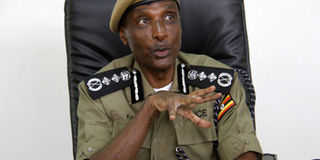DNA tests pin two suspects to Entebbe murders

Inspector General of Police, Kale Kayihura. FILE PHOTO
What you need to know:
According to DGAL document, eight of the samples picked from different crime scenes in Nansasa Municipality matched the DNA of Ibrahim Kaweesa a boda boda cyclist, while five of the samples picked in Katabi Town Council matched the DNA of William Ssenoga.
The Uganda Police Force appears to have made a breakthrough in identifying the people behind the killing of young women in Entebbe and Nansana areas.
Police detectives have been hunting for the killers of more than 19 women in Entebbe, Katabi and Nansana in Wakiso district between June and September.
The killings which were done in a similar way included; attacking young women in the middle of the night, sexually assaulting them, strangling them to death and inserting sticks in their private parts.
Police have finally come to a conclusion of who exactly were behind the killings after forensic evidence pinned two of the 13 suspects arrested two months ago.
Police at the beginning of this week received results of the analysis from the Directorate of Government Analytical Laboratory (DGAL) to compare semen samples picked from the victims to the DNA of two of the suspects.
According to DGAL document, eight of the samples picked from different crime scenes in Nansasa Municipality matched the DNA of Ibrahim Kaweesa a boda boda cyclist, while five of the samples picked in Katabi Town Council matched the DNA of William Ssenoga.
The Inspector General of Police (IGP) Kale Kayihura also confirmed the breakthrough and thanked the team of detectives and other security agencies that have been investigating the killings.
"We now have both the confessions and the scientific evidence to back our findings. Unfortunately our criminal justice system says even these guys are innocent until proven guilty by a court of law so we are waiting for our final victory in court," Kayihura said.
While the samples were collected two months ago from the scenes of crime and from the victims and stored in Wandrgeya, nothing had been done to analyse them until last week.
The Government Analytical Laboratory did not have reagents to use in analysis of the samples.
.
Kayihura says police had to find some reagents for the analysts to use and bring the investigation to a conclusion.
"DGAL doesn't have a budget for some reagents and that sometimes interferes with the smooth running of our investigations," Kayihura says.
Most of the arrested suspects, including Ssenoga and Kaweesi, were picked after witnesses testified to police that they had been seen with the victims on the nights they disappeared and were found killed.
Kaweesa was also implicated by a group of boda boda cyclists who claimed to have seen him taking one of the victims into the bush where her body was found three days later.


